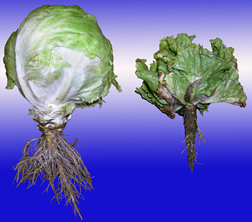This page has been archived and is being provided for reference purposes only. The page is no longer being updated, and therefore, links on the page may be invalid.
Superb Iceberg Lettuces Resist Corky Root, Mosaic Virus
By Marcia WoodMarch 23, 2007
Crispy, crunchy, and low in calories, iceberg lettuce commands a starring role as America's favorite lettuce for salads, burgers, and even wraps. In the lettuce field, however, iceberg faces attack from an array of microbes that are harmless to humans but deadly to this vegetable.
That's why Agricultural Research Service (ARS) plant geneticist Edward J. Ryder, now retired, and colleagues Ryan J. Hayes and Beiquan Mou at Salinas, Calif., developed seven kinds of parent iceberg lettuces that shrug off attack by two microbial enemies.
One, a disease known as corky root, causes lettuce roots to develop ugly, yellow-to-brown lesions that harden to a corklike texture. Corky-root-infected plants may produce stunted heads 30 to 70 percent smaller than normal. The bacterium Sphingomonas suberifaciens causes the disease.
The other headache, lettuce mosaic, is caused by a virus of the same name. It results in stunted growth as well as unattractive mottling of leaves. Green peach aphids, about one-eighth-inch long, can spread the virus from an infected plant to an uninfected one as they move about a lettuce field, sipping plant juices.
The parent plants debuted in 2006 as the first publicly available crisphead lettuces—developed especially for California climates and soils—that come equipped with powerful natural resistance to both microbes. California is the country's No. 1 lettuce-producing state.
These new lettuces joined the ranks of others developed at the agency's U.S. Agricultural Research Station in Salinas.
Breeding strong natural resistance into lettuce still prevails as the most economical way to defend the lettuce from disease-causing microbes.
The researchers' work isn't over yet. For example, Mou and co-investigator Carolee T. Bull, an ARS plant pathologist at Salinas, are searching for corky-root-resistance genes that are different from the one already working inside the new parent lettuces.
Why the need to hunt for more genes? Giving lettuce additional corky-root-resistance genes may bolster the plant's defenses, according to Mou.
ARS is the U.S. Department of Agriculture's chief scientific research agency.


